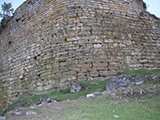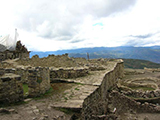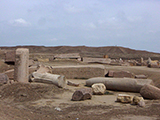Raiders of the Lost Ark
Raiders of the Lost Ark | Temple of Doom

In Raiders of the Lost Ark, Indiana Jones finds himself searching for the Ark of the Covenant. To locate this elusive treasure, Indy must do what archaeologists are known to do… research, plan, and then dig. Most of what you see depicted in the film is completely fiction, however the ideas behind the story are all too real.

The Chachapoyans
The adventure begins with Indy in South America searching for a priceless Chachapoyan fertility idol. Using fragments of old maps he has collected, Indy makes his way through the jungle to a hidden temple. Finally, after venturing through a booby-trapped maze, Indy finds the idol resting atop a stone podium. Indy retrieves the idol and the famed action of the boulder chase and pursuit by the deadly Hovitos (fictional descendants of the Chachapoyans) commences.
While there may not have been a real golden idol or Chachapoyan temple with a giant boulder, it is important to know that the Chachapoyans were a real native population that lived in the Andes of Peru in the years prior to the Spanish conquest of South America. Known as the Warriors of the Clouds, the Chachapoyans lived in the high altitudes of the Andes. There they farmed and lived amongst the lush vegetation of the Amazonian region.
Sometime after 1450, the Inca moved in and consumed the Chachapoyan society. Little is known about these events, but there are surviving accounts from Spanish Chronicler Cieza de León that outline the history and ultimate destruction of the Chachapoyan people. Shortly after the Inca took control, the Spanish conquest began and the remnants of the Chachapoyan culture were lost. Today, much archaeological evidence remains and it is from these sources that we have learned the most about the Warriors of the Clouds.
One site in particular has similarities to the Chachapoyan temple found in Raiders of the Lost Ark. The fortress of Kuelap remains with its long, high walls (600 meters in length, 110 meters in width, and 19 meters high) and remnants of more than four hundred buildings. Radiocarbon dating indicates the site was constructed as early as the 6th Century AD and was used throughout the pre-Columbian period. Similar to Raiders, the entryway to Kuelap is long and very narrow. Archaeologists believe the entrance was designed this way so that it could be easily defended as only one attacker could fit through the entrance at a time. Many Chachapoyan grave sites and mummies have also been located amongst the ruins of Kuelap.
Kuelap remained unknown to the outside world until 1843 when a local named Juan Crisóstomo Nieto completed the first known survey of the site.
Learn More
-Dr. David West Reynolds: The Archaeology of Indiana Jones-The Interior: Chachapoyas, Kuelap and Cajamarca
-Discovery could bring Peru's 'cloud warriors' to earth

Hitler and the Occult
In Raiders of the Lost Ark, Indy meets with Army Intelligence officers who tell him Hitler’s “obsessed with the occult” and pursuing the Ark of the Covenant. The film’s story hinges on believing that Adolf Hitler was an occultist in search of religious and mythical artifacts that would increase his power… possibly to that of a god-like status.
As farfetched as it seems, there is evidence to suggest that Adolf Hitler viewed himself as a messiah or savior of the German people. During his time as Germany’s Furher, Hitler and the Nazis actively pursued holy treasures from around the world. Did he hope that such relics would grant him the power of world domination he so desperately desired or was he merely a collector pursuing priceless treasures? One thing is certain, whatever mythical relics Hitler obtained, none helped him conquer the world or achieve immortality.
As the Nazis expanded their borders and influence, Hitler pursued and retrieved numerous religious artifacts. Of course, the authenticity of the items he collected and sought is debatable, but the Nazis nonetheless hunted for such items. Some of the known artifacts they collected or pursued include The Spear of Destiny, The Holy Grail, and of course, the Ark of the Covenant. Stolen relics from the Holy Roman Empire regalia included the Imperial sword of St. Maurice, the Holy Lance, Imperial Crown, and Imperial orb. Several of these objects are rumored to have mythical powers.
Further proof of the Nazi obsession with mythical objects and powers was the creation of the Ahnenerbe, a Nazi establishment that claimed to "study society for Intellectual Ancient History." In Raiders of the Lost Ark it would have likely been the Ahnenerbe that planned and led the expedition to search for the Ark of the Covenant. The Ahnenerbe or "Study society for primordial intellectual history, German Ancestral Heritage, registered society" as it was formally known, was founded in 1935 and was led by Heinrich Himmler, Herman Wirth, and Richard Walther Darré. The goal of the Ahnenerbe was to research the cultural history of the Aryans or the so-called master race championed by Hitler and the Nazis. In truth, the Nazis were seeking to and did exaggerate their own history to promote the supposed Aryan superiority.
The group sponsored numerous expeditions around the world trying to prove that the Nordic people (including mythical figures) had once ruled the world. Ahnenerbe expeditions included journeys to Antarctica, the Middle East, Tibet, Ukraine and Poland. The Tibet expedition led to Nazi claims that Germanic peoples had once conquered much of Asia and that Siddhartha Gautama, the Buddha, was himself of Aryan descent. In Italy, the Nazis claimed to find Nordic runes that linked the Ancient Romans to a Nordic heritage.
While we cannot be sure to what extent Hitler actually hunted religious artifacts for their power, we do know that he was quite the collector of treasures. Across Europe, Africa, and Western Asia the Nazis looted thousands of priceless treasures from museums, churches, synagogues, homes and private collectors. The theft was so expansive and culturally destructive that author Lynn H. Nicholas referred to it as “the Rape of Europa.” Most treasures were returned to their owners after the war, but thousands of items remain unclaimed or lost.
Learn More
-JVL: Adolf Hitler Bio-History.com: Adolf Hitler Bio
-The Third Reich's Pillage of European Art and Treasures
-About St. Maurice
-The Origin of the Cult of St. Maurice
-Ahnenerbe Expeditions Google Map
-Article- Hitler's Willing Archaeologists
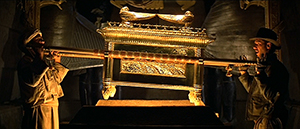
The Ark of the Covenant
The major McGuffin of Raiders is the Ark of the Covenant. In the film, Indiana Jones is racing against the ruthless and brutal Nazis to find the Ark first. It is made clear that Nazi Furher, Adolf Hitler, plans to use the power of the Ark to aid him in his pursuit of world domination. Indy eventually finds the Ark only to quickly lose it to the Nazis. In the end, however, doom awaits the careless and greedy Nazis as the power of the Ark or wrath of God proves to be more than they can understand or control.
According to the Book of Exodus, after Moses broke the original tablets containing the Ten Commandments, God commanded that they be placed in an ark. Two cherubim were placed atop the ark’s cover and it is from there that God communicated with Moses. The ark was always covered and exhibited extreme power. The Book of Joshua tells us the Ark’s power resulted in the destruction of the walls of Jericho after the Israelites marched it around the city for seven days, accompanied by seven horns and finally a shout.
In the Book of 1 Kings, it is revealed that the Ark was taken to Jerusalem and placed in Solomon’s Temple where it remained until the Babylonian conquest and destruction of the temple in 586 BC. Following the Babylonian invasion, no records of the Ark exist. It is widely believed that the Babylonians took the Ark to Babylon along with other treasures.
Another theory involves Shishak, an Egyptian Pharaoh who invaded the Kingdom of Judah around 920 BC. According to the Holy Bible, Shishak stole many of the treasures of the temple in Jerusalem. Could the Ark of the Covenant be one of Shishak's stolen treasures? In Raiders of the Lost Ark the story of Shishak is used to place the Ark at Tanis.
Debate and mystery surround the ark and its power, but most believers conform to the information found in holy texts. Perhaps the biggest mystery of all is determining what happened to the Ark of the Covenant. Theories of the Ark’s current whereabouts range from Ethiopia to Britain and from Chartres Cathedral to Egypt. One of the more common theories is that the Knights Templar recovered the Ark of the Covenant during the Crusades and brought it back to Western Europe where it remains hidden and protected to this day.
Learn More
-A Lead on the Ark of the Covenant-New Advent: Ark of the Covenant
-Will this be the first time the world sees the Ark of Covenant?
-Jewish Encyclopedia: Ark of the Covenant

Tanis
Upon his call to adventure, Indiana Jones discovers that the Nazis are searching for the lost Ark of the Covenant in the ancient Egyptian city of Tanis. It is there that Indy and his friend Sallah locate the Well of Souls and ultimately the ark itself.
The real city of Tanis was located in Northeast Egypt along the delta of the Nile River. It was founded during the late Twentieth Dynasty (1187 to 1064 BC) and eventually became the capital of Northern Egypt. The site hosts ruins of numerous ancient temples, at least two sacred lakes, and a royal necropolis (burial ground). There is little evidence to suggest the Ark of the Covenant was ever located in Tanis.
The royal tombs of Tanis were discovered by Pierre Montet in 1939. The tombs of Psusennes I, Amenemope and Shoshenq II avoided looting in antiquity, thus Montet found the tombs intact and full of treasures. Amongst the jewelry, precious stones, and gold were the funerary masks of all three pharaohs, but no Ark.
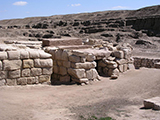 The Royal Tombs of Tanis |
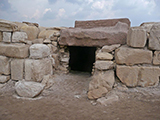 The tomb of king Osorkon II |
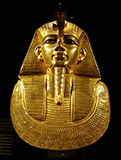 The funerary mask of pharaoh Psusennes I |
Learn More
-NatGeo: Tanis-Buried city revealed by satellite
-Treasures of Tanis
-Tour Egypt: Tanis

The Flying Wing
After being left to die in the Well of Souls, Indy and Marion escape and quickly discover that the Nazis plan to fly the Ark back to Germany. The plane the Nazis will use is no ordinary plane, rather it’s a radical new design commonly referred to as a "flying wing." In one of the most memorable fight scenes from the film, Indy and Marion sabotage the plane and force the Nazis to relocate the Ark via truck convoy.
In the last months of World War II, American soldiers discovered an innovative and secret weapon being developed and tested by the Nazis. The odd looking plane they found was the Horton 2-29, more commonly known as Hitler’s Stealth Fighter. The plane was mostly made of wood, powered by two jet engines, and seemingly molded into one cohesive wing. Intrigued, the US military disassembled the plane and shipped it to the United States where it was studied by "top men." The plane was eventually stored and largely forgotten for 60 years.
In 2009, National Geographic and a team from the Northrop Grumman defense-contracting corporation studied the remaining Horton 2-29 and original Nazi blueprints. Their goal was to build a full-size, but non-flying replica of the unique plane. The study revealed that the plane was more advanced than first thought. Although made of wood, the 2-29 was equipped with primitive stealth capabilities (possibly accidentally). The plane was armed with four 30mm cannons and two 1,100-pound bombs. Had the Nazis had time and resources to put the Horton 2-29 into combat, it could have possibly turned the tide of war in their favor.
Learn More
-"Hitler's Stealth Fighter" Re-created-Hitler's Stealth Fighter reveals Nazi Germany's top-secret development of radar-evading technology
-Flying Under the Radar: A History of Stealth Planes
Disclaimer: All resources (including books and websites) provided on indyintheclassroom.com are intended to be used by educators. Indyintheclassroom.com is not responsible for the content on linked websites.
Copyright: All images on Indyintheclassroom.com are used with permission or are in the public domain. Exceptions are noted. For additional information see our Copyright section. |
Raiders of the Lost Ark | Temple of Doom

